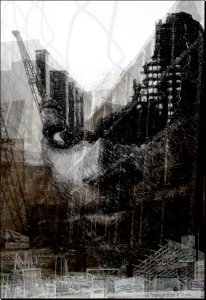
The Black Metropolis: An Oral History of the Rise and Fall of Public Housing in an Historic Chicago Neighborhood
 The Black Metropolis: An Oral History of the Rise and Fall of Public Housing in an Historic Chicago Neighborhood is a full length oral history of residents that grew up in public housing developments before they transitioned into crime, drug and gang infested contested areas.
The Black Metropolis: An Oral History of the Rise and Fall of Public Housing in an Historic Chicago Neighborhood is a full length oral history of residents that grew up in public housing developments before they transitioned into crime, drug and gang infested contested areas.
Produced and Directed by Theodoric (Ted) Manley, Jr.
This DVD depicts the personal histories of residents that grew up and currently live in Chicago public housing--that is currently being demolished--in the Douglas and Grand Boulevard neighborhoods. A vast majority of these residents (over two-thirds) will be displaced to make way for mixed income housing. The DVD challenges the stereotypical ways these tenants have been portrayed by the media representing a vastly different portrait of public housing in a place called Bronzeville—its history, its transition, and its future as a Black community.
Excellent learning and teaching tool for students and teachers in:
*Urban Studies
*Black/Ethnic and Racial Studies
*Urban/Housing Policy
*Community Planning and Development
Reviewer comments:
“Interviews with residents are informative and sensitively presented; we hear the voices of people who lived in Bronzeville and learn about their lives and experiences. The material will lend itself very well to class discussion since it reflects the complexity and ambiguities of public housing. For example, the viewer sees the injustice of segregation and exclusion, yet also learns that the early years of CHA housing were remembered as positive experiences with opportunities for sports, education, music, religion, and good times with neighbors. There will be many questions and issues that students will want to talk about after they have watched The Black Metropolis—questions such as the causes of decline, the implications of tenant screening policies, the reasons for changes in government policies that precipitated decline, and the effects of the new transition plan on residents and on the city as a whole.” Roberta Garner Professor and Chair, Sociology Department, DePaul University
The Way They Saw It is a moving documentary of the historic Bronzeville area, located south of downtown Chicago. Through photos, student reflections, and interviews with the inhabitants, Theodoric Manley, Jr., and his students show the plight of African-Americans who are being forced from their homes through rezoning. Manley traces the Great Migration from the Jim Crow South to the Black Metropolis and shows the rise of many historical figures. Now redevelopment is forcing out the original inhabitants, and condominiums are replacing the former culture-laden landmarks. As the students explore Bronzeville, you will be moved by their reflections on the reclaiming of the historic area by downtown Chicago. This comprehensive study of Black versus White America shows that racism isn’t dead. To purchase this publication go to: http://www.dorrancebookstore.com/waythsawitch.html 2009.
The Revanchist City: Downtown Chicago and the Rhetoric of Redevelopment in Bronzeville Theodoric Manley, Jr., Avery Buffa and Caleb Dube
Keywords: redevelopment, rent gap, displacement, disinvestment, reinvestment, urban poor. This paper examines and interprets the contrived public and private cycle of disinvestment and reinvestment in Bronzeville—the original settlement area of Blacks in Chicago. The historical, political, economic, and social policy of racial confinement and segregation in Chicago created a high concentration of public housing in Bronzeville. Using census data we develop trend lines that show how the rent gap is linked to the process of disinvestment and reinvestment by contrived and planned public and private policies to ill-develop and redevelop Bronzeville. Under the rhetoric and language of being concerned for the well-being of the urban poor, the primary goal of downtown Chicago, public and private interests, Black middle class pioneers, and White upper class elites is to reclaim urban space for the creation of a Black middle and White upper-class elite consumer base in Bronzeville, as well as a space of cultural consumption for tourists. 2009.
Since the last half of the twentieth century what has happened to the infamous "Black Belt?" Or what St. Clair Drake and Horace Cayton (1945) in their monumental study titled, The Black Metropolis: A Study of Negro Life In a Northern City. Who left and why? Who stayed and why? What did African Americans accomplish during this period in terms of political, social, cultural, economic and other resources? Who has failed? What were the blocked opportunities? What opportunities exist now? What has remained the same? What has changed? And finally, what lies ahead in the millennium? These questions frame our discourse on understanding the trials and tribulations that have confronted African Americans who once lived in the Black Metropolis and those who "continue" to live there. This web page is designed for students, teachers, and community members invested in understanding changes in the Black Metropolis since the last-half cenutry.
The
Hoop
Institute

- Home
- About Us
- Class Curricula
- Publications
- Site Photographs
- Current Projects
- Staff
- Board of Directors
- Contact Us
- Register for Classes
- Site Map
- Search
- Recent News
- The Black Metropolis
- Register to Take the RDFP Survey
- User Login



